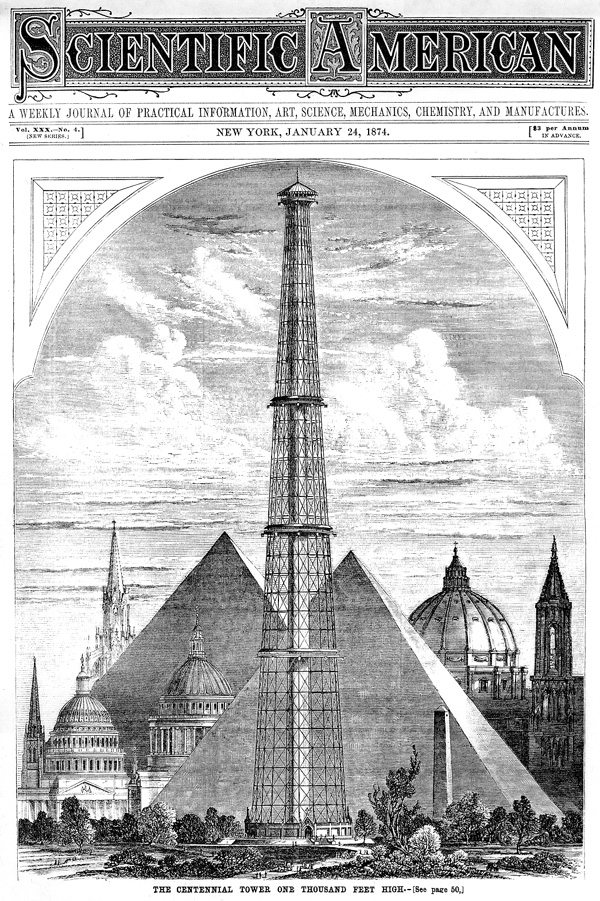
University of California, Irvine
Instructor: Dr. Barbara J. Becker

|
Week 9. Designing Alternatives "The Centennial Tower One Thousand Feet High"
and "A One Thousand Foot Tower"
|

|
___________________ - January 24, 1874 - THE CENTENNIAL TOWER ONE THOUSAND FEET HIGH.
It is but natural for the mind to commemorate a great event by the erection of a colossal structure. The oldest of ancient nations formed brick and made mortar, and built for themselves a tower to record their existence; we, youngest of modern peoples build us a tower to celebrate the close of the first century of our national life.... The graceful shaft of metal, rearing its summit a thousand feet above the ground, forms a fitting contrast, typical of the knowledge and skill which intervening ages have taught mankind. "But how high, comparatively speaking, will this thousand foot structure appear?" doubtless is a question already in the mind of the curious reader. Beside the mighty works of Nature, we answer, infinitely small; beside the works of man, colossal. The reader can draw the contrast for himself, by a glance at the admirable effort of both artist and engraver, to which our initial page is devoted. Here are grouped the highest structures in the world; and in the center and springing far above them all, is the airy network of the great tower. The designers are Messrs. Clarke, Reeves & Co., civil engineers and proprietors of the Phoenixville Bridge Works, of Phoenixville, Pa., a firm represented by its productions throughout the whole country, and regarding whose ability to carry through an enterprise of this kind no corroborative assertions on our part are at all necessary. The material is American wrought iron, made in the form of Phoenix columns ... united by diagonal tie bars and horizontal struts. The section is circular, and is 150 feet in diameter at the base, diminishing to 30 feet at the top. A central tube, 30 feet in diameter, shown in [a cross-section view], extends through the entire length, and carries the four elevators.... The latter are to ascend in three and descend in five minutes, so as to be capable of transporting about 500 persons per hour. There are also spiral staircases winding around the central tube. The bracing ... runs in every direction, so that the tower will be as rigid as if made of stone, and yet will expose very little surface to the wind. The proportioning is such that the maximum pressure resulting from the weight of the structure, with persons upon it, and a side wind force of 50 lbs. per square foot, will not strain the lowest row of columns over 5,000 lbs per square inch. The four galleries are roofed over and protected with wire netting, in order to prevent accidents. The estimated cost of the fabric is one million dollars, and the necessary time for construction, the designers tell us, need not exceed one year. The site has not been as yet definitely located, but it will probably be in Fairmount Park, Philadelphia, in proximity to the buildings of the Centennial Exposition. By calcium and electric lights from the tower, it is suggested that the latter, with their adjoining grounds, might be brilliantly illuminated at night. The summit of the spire would also form a magnificent observatory, while the view of the surrounding country would be unparalleled. It is hardly necessary for us to point out the very appropriate character of the design in connection with the object of its erection. That the hundredth anniversary of our national existence should not pass without some more permanent memorial than that of an exposition, which, within a few months from its close, will have disappeared, seems to us eminently proper. It is clear that, within the coming two years, no monument of so imposing a nature, or of so unique and original conception, can be constructed of any other material than iron, nor, indeed, can we hope to erect a fabric more completely national in every feature. Not only then shall we commemorate our birthday by the loftiest structure ever built by man, but by an edifice designed by American engineers, reared by American mechanics, and constructed of material purely the produce of American soil. |
|
___________________ - January 10, 1885 - A ONE THOUSAND FOOT TOWER.
In January, 1874, the SCIENTIFIC AMERICAN gave the drawings and details of a one thousand foot tower which was proposed to be constructed by Clarke, Reeves & Co., in Fairmount Park, Philadelphia, Pa., near the Centennial Exhibition grounds. This idea was not carried out, but it has just been taken up again in France. The example of the largest buildings that have been constructed up to the present shows that it is difficult, with materials in which stone plays the chief role, to exceed a height of from 490 to 525 feet, which may be considered as a limit rarely reached. In fact, the principal heights of known buildings are as follows:
In order to exceed these heights it is necessary to have recourse to the use of metal, which is the only material that permits not only of supporting the vertical reactions of the structure, but also of resisting the stresses of flexion resulting from the action of the wind, which is considerable for great heights. It is such an application that has permitted the authors of the project of which we are speaking to propose a monumental tower that they have no fear of carrying up to a height of 300 meters (984 feet), and which will thus be nearly double that of the highest monuments known. This height of 300 meters might again, if need be, be notably exceeded. The tower is designed, in the mind of its projectors, to form part of
the structures that will be erected on the occasion of the Universal Exhibition
of 1889.
The one on the first story, the flooring of which will be 230 feet from the ground, presents a superficies of about 5,400 square feet. At the lower part, and in each of the faces is a large arch of 230 feet opening, forming the principal element of the decoration. It gives the tower that monumental aspect which is indispensable for the purposes for which it is intended. At the apex there is a glass cupola from whence a vast panorama may be seen by the spectator. This part will be reached by elevators in the interior of the uprights, so arranged as to give absolute security. Aside from the attraction and monumental aspect that will be presented by this tower, the boldest manifestation of engineering art of our epoch, it will be susceptible of different uses that will be taught by experience, and, among which, we can already foresee the following: 1. Strategic Observations.--In case of war there may be seen from the tower all the movements of the enemy within a radius of ten miles. 2. Communications by Optical Telegraphy.--In case of an investment, or of suppression of the ordinary telegraph lines, it will be possible from this elevated post to communicate by optical telegraphy with places at a considerable distance, such as from Paris to Rouen, for example, where the second observer will be placed upon a high hill. 3. Meteorological Observations.--An observatory at 984 feet above ground does not as yet exist, and a large number of questions notably the direction and violence of atmospheric currents at such a height, has not yet been solved. 4. Astronomical Observations.--At this great height, the purity of the air, and the absence of the fogs that often cover the horizon of Paris, will permit of a certain number of observations that are now nearly impossible in ordinary weather in this city. 5. Electric Lighting at a Great Height.--By arranging electric lights of sufficient power upon this tower, as has been done in certain American cities, it will be possible to obtain a general illumination whose advantages have long been recognized, but which has not yet been realized on a vast scale. In this way the entire exhibition and its approaches may be lighted in the completest and most agreeable manner, by means of a single luminous center. Still other applications may be foreseen, either in the domain of practice, such as the indication of time to a great distance, or in the domain of science, which will for the first time have at its disposal a height of 984 feet that will permit of studying the fall of bodies, the resistance of air at different velocities, certain laws of elasticity, the compression of gases or vapors, the planes of oscillation of the pendulum, etc., etc.--Les Annales des Travaux Publics. |
|